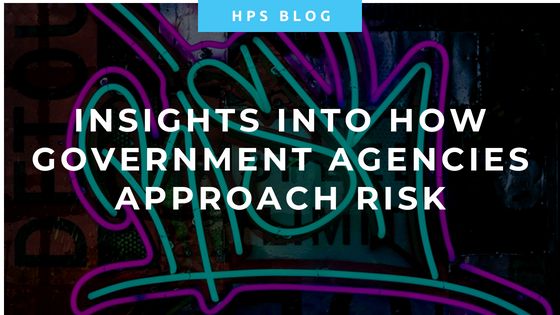Insights into how government agencies approach risk; a fresh approach.

Enterprise Risk Management (ERM) fundamentally is being pushed by concern for the cost of risk events and a heightened awareness of such events. In this respect it reinforces and feeds into the general governmental aversion towards risk. Innovation has always been incremental in government; that’s not a criticism by the way. Their is often good reason for that. However, by better examining risks and identifying mitigative actions, government agencies can find innovative solutions to the problems they face.
HPS friend and fellow quality advocate and leading risk specialist, James (Jim) Kline, shared with me part of his research for his new book on risk in government. Jim comments, “There are multiple drivers behind this fresh approach to managing risk. Probably the two most important are firstly; the changing nature of the environment that government agencies and businesses operate in. The globally interconnected economy is volatile, complex and that creates uncertainty. Further, the 24/7 news cycle heightens the awareness of risk events and their costs. We are instantly aware of the devastations caused by floods and other natural disasters. Cyber attacks are now regularly in the news. This heightened awareness of risk is the second major driver”.
The benefits of viewing certain risks as a positive event are several. According to Jim, The Electric Power Board of Chattanooga, Tennessee is a prime example. “ VW wanted to locate a plant in the area. However, they were concerned about power outages caused by Tornados. A common event in the region. The Power Board agreed to move to fiber optic cable. In the process they installed automatic meters and switching. They also added high speed internet. The automatic meters reduce personnel costs, the switching and fiber optics reduce repair costs and the high speed internet added a new revenue stream. Yuma County in the U.S. reports improved communication among departments. Most government users report improved efficiency, although there are not any studies to verify this. Virginia Beach reports that the use of weather sensors allowed them to warn residents of potential flooding 48 hours in advance. This helped them reduce the adverse impact of the flood. The Power Board also saw a reduction in damage. The mitigation of damage may be the greatest benefit, since the adverse impact of severe weather is very costly. Any mitigation of damage is beneficial to government, business and citizens” says Jim. Examples that endorse the Deloitte sponsored report into Risk and how a positive approach to managing risk can add value. This report was referenced in my earlier blog titled ‘Not doing risk is risky’. You can download a copy of the Deloitte report from the blog by the way.
I also asked Jim to comment on moves towards centralised integrated management systems where ERM forms the backbone. Jim told me that in the UK and to some extent in Australia, he sees a tendency towards a Good Governance Framework. This framework includes ERM. Jim goes on to comment, “That said I have not seen such a framework in Canada or in the US. I know that MS 1000:2014 is out there. However, I haven’t seen it getting much traction. It is not referenced in any of the government documents I have seen. So at this point, I do not see a broad based movement towards a unified management approach in government at least in North America”.
I had the pleasure in interviewing Jim as part of writing this blog. You can listen to our full interview here. Jim expands on his comments made here as part of the research he undertook in writing his book.
Get informed by listening to my interview with Jim, if you want to subscribe and grab a copy of his new book please email me and then let’s start a conversation. I promise there are no ‘catches’ in these links, we simply want to educate and inform. If you want to connect and start a conversation our contact details are below.
Based in Portland, Oregon, James J. Kline (pictured above) is a Senior Member of ASQ, a Six Sigma Green Belt, a Manager of Quality/Organizational Excellence and a Certified Enterprise Risk Manager. He has over ten year’s supervisory and managerial experience in both the public and private sector. He has consulted on economic, quality and workforce development issues for state and local governments. He has authored numerous articles on quality in government and risk analysis.Feel free to share this blog too.







